
Types of Tongs
Shop All Kitchen Tongs
What Are Tongs?
Tongs are a type of kitchen utensil that help users grab onto foods to lift, flip, toss, or serve them without hand contact. They can help keep hands away from hot cooking surfaces and flames as well as prevent cross-contamination.
What Do Tongs Look Like?
Tongs feature two arms (each arm is called a tong) that have large, spoon-like tips at the end to grab and hold food. Tongs have either a one-piece construction or arms connected by a riveted hinge that allows the user to hold the tongs by the top and squeeze the arms together to grab onto items. Tongs come in a variety of shapes, sizes, and tip styles to help accomplish specific tasks.
What Are Tongs Used For?
Tongs make it easy to cook foods while safely keeping hands and arms from the hot surface as well as to serve foods that would be awkward to handle with regular serving utensils. They can be used for flipping steaks and barbecued meats, tossing pasta, serving salads, and decorating plates.
Tong Types
Tongs are designed to keep hands safe while cooking and away from food while serving. There are many different types of tongs and each has a 'best' use that can help streamline your service. Let's go over the 12 most common tong types to help you decide which tongs you need for your kitchen.
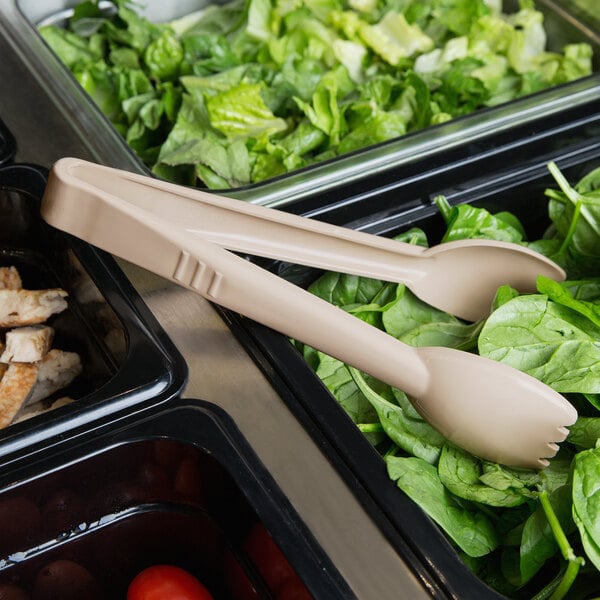
1. Salad Tongs
Traditional salad tongs have one spoon and one spork to mix and serve helpings of salad as well as serve fruit, rolls, breadsticks, and pastries. Salad tongs are made of either plastic or stainless steel and are mainly reserved for front-of-house use. Plastic salad tongs come in a variety of colors and allow you to create a color-coded system within your establishment to avoid cross-contamination.
- Great for restaurants, salad bars, catering events, weddings, and buffets
- Typically feature a one-piece construction for sanitary use
- Range in length from 6" to 11"

2. Ice Tongs
Ice tongs feature crow feet-shaped ends that help grab slippery single cubes of ice for cocktails and other beverages. This design also serves as a draining mechanism for liquids to ensure your craft drink or liquor isn't watered down. Ice tongs are also great for grabbing garnishes, sliced fruit, cheese cubes, and deli meat cubes. They are made of stainless steel to ensure a firm grip and easy cleaning.
- Great for bars, hotels, restaurants, and catered events
- Typically feature a one-piece construction for sanitary use
- Range in length from 5" to 9"

3. Serving Tongs
Serving tongs are designed to grab and plate a variety of foods like grilled meats, flaky fish, hors d'oeuvres, and baked goods. They are usually made from stainless steel and have a decorative look or finish since they are often used to plate food in buffet restaurants and banquet settings. Serving tongs also come in various arm styles based on the food that you are serving.
- Great for banquets, catering events, weddings, and buffets
- Typically feature a one-piece construction for sanitary use
- Range in length from 6" to 14"
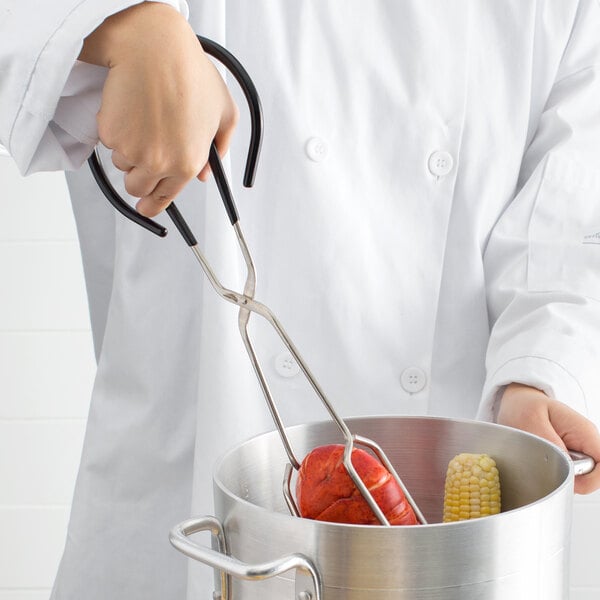
4. Scissor Tongs
Scissor tongs have two handles, thin arms, and thin, square metal ends. They feature either an all-metal construction or have metal arms with coated handles to ensure a firm, comfortable grip. Scissor tongs help grab bulkier items, such as steamed seafood, corn on the cob, or heavy meats, without losing your grip. They are also useful for serving soft dough items like dinner rolls, bagels, and pastries without denting their exterior.
- Great for restaurants, catering events, and buffets
- Typically feature a riveted, two-piece construction
- Range in length from 10" to 15"
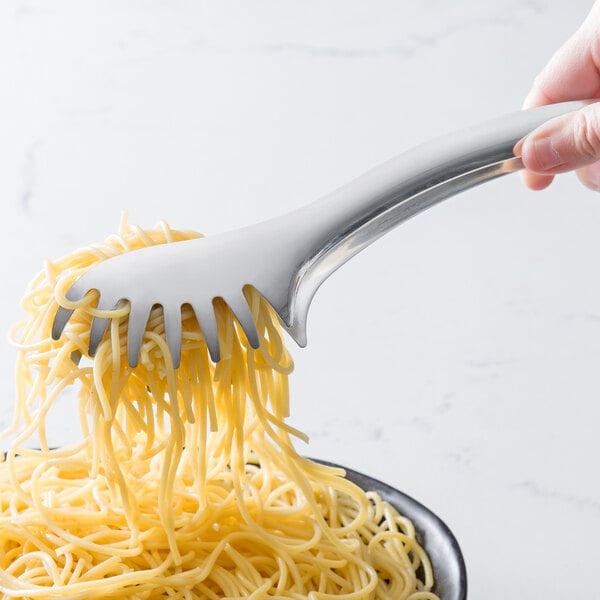
5. Pasta Tongs
Pasta tongs, or spaghetti tongs, are made of metal and feature long, tooth-like ends that make it easy to grab, toss, and plate slippery noodles. They are great for placing at your pasta buffet for guests to easily serve themselves large portions of any pasta type. Or, you can serve them with your shared pasta dishes at your bistro. Pasta tongs are also often used to toss and serve salads with ease.
- Great for banquets, catering events, restaurants, and buffets
- Typically feature a one-piece construction for sanitary use
- Range in length from 8" to 12"
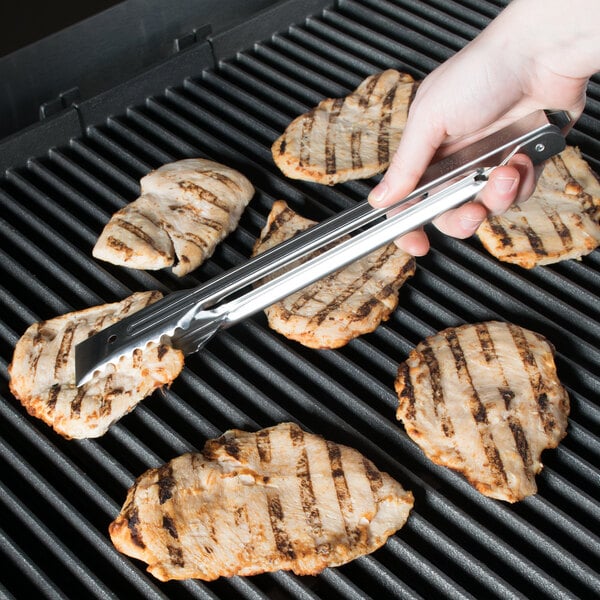
6. Locking Tongs
Locking tongs are usually made from stainless steel and feature either a bar that slides over the handles or a locking mechanism at the top of the handle to hold them securely in place when not in use. Locking tongs are used the same as utility tongs are, and the added locking feature makes them convenient to store and conserve space in your utensil storage space. This design makes them easy to transport, making them great for catering companies.
- Great for restaurants, food trucks, kiosks, ghost kitchens, and caterers
- Typically feature a riveted, two-piece construction
- Range in length from 7" to 22"
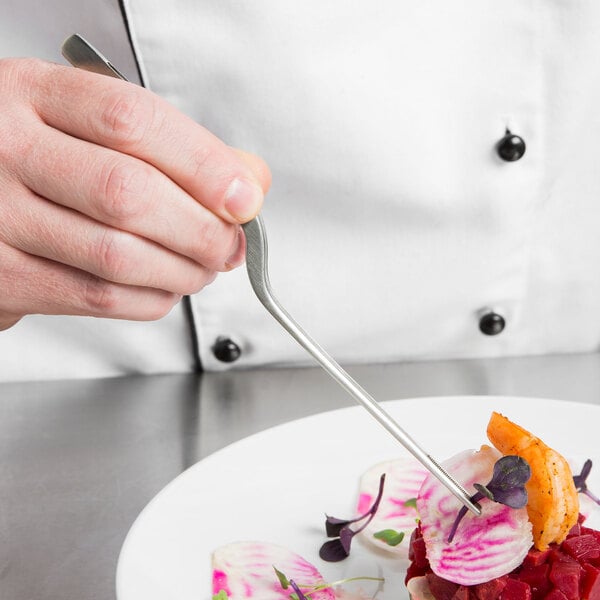
7. Plating Tongs
Plating tongs, or precision tongs, are tweezer-shaped tongs that are used for the precise plating of delicate garnishes and food. They are made from stainless steel and feature either straight, curved, or offset ends to provide greater control for delicate foods and difficult-to-place angles. Some plating tongs are also great for gently pulling bones from fish without damaging the fish or breaking the bones.
- Great for restaurants, bars, hotels, and catered events
- Typically feature a one-piece construction for sanitary use
- Range in length from 6" to 12"

8. Flat Tongs
Flat tongs, or pastry tongs, feature paddle-like ends with either a smooth finish or a ribbed design for an enhanced grip. Because their ends don't come to a point, flat tongs won't damage the texture, glazes, or coatings of soft or delicate foods, such as rolls, baked goods, and flaky fish. They are made from either stainless steel or plastic, and the steel tongs often have a polished finish since they are often used to plate food in buffet restaurants and banquet settings.
- Great for bakeries, cafes, buffets, catered events
- Typically feature a one-piece construction for sanitary use
- Range in length from 5" to 16"

9. Utility Tongs
Utility tongs are general-purpose tongs that can be used as cooking tongs in the kitchen or as serving tongs in your buffet line or salad bar. These tongs are made with stainless steel and feature medium-sized, scalloped ends to ensure a firm grip on foods. Utility tongs are excellent for general kitchen tasks like flipping meats on the stovetop, handling veggies like asparagus, and grabbing food from the deep fryer.
- Great for all foodservice operations
- Typically feature a riveted, two-piece construction
- Range in length from 6" to 16"
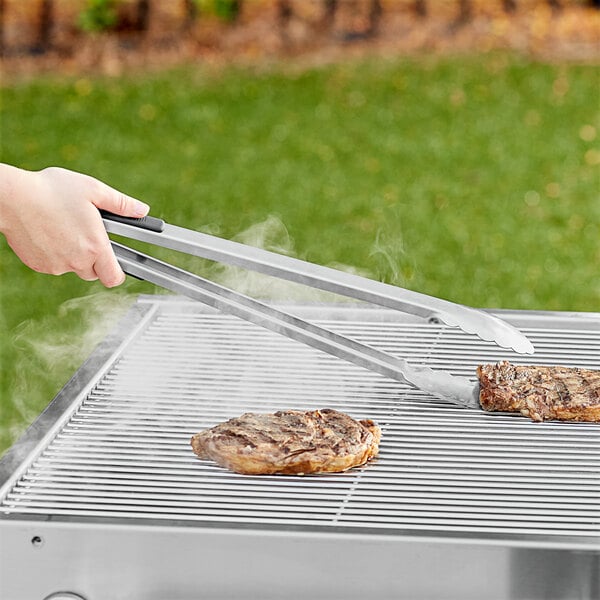
10. BBQ Tongs
Barbecue tongs are similar in appearance to utility tongs but are longer in length to protect operators from the hot flames of a grill while grabbing and turning meats, fish, and vegetables. The arms are often made of stainless steel to handle the high heat of grills and smokers while the handles are often coated with a non-heat-conducting material to protect a user's hands. To combat the long length, many BBQ tongs also have a locking feature with a hanging hole for easier storage.
- Great for restaurants, bars, tailgates, and BBQ joints
- Typically feature a riveted, two-piece construction
- Range in length from 16" to 21"
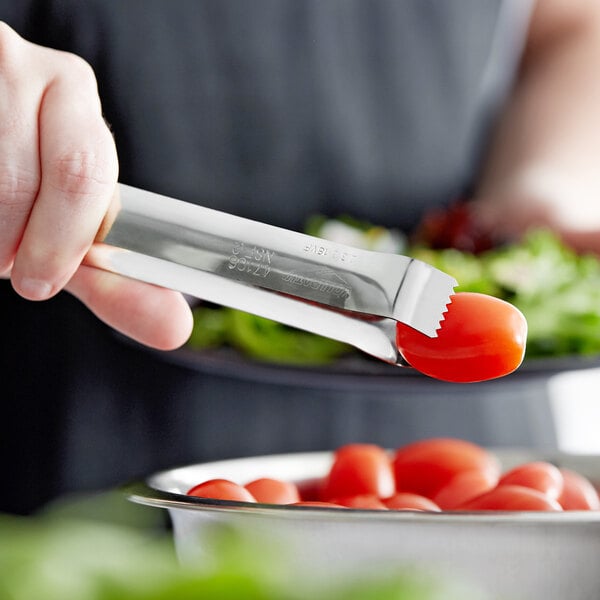
11. Pom Tongs
Pom tongs have lightly serrated ends that make it effortless to serve hard-to-grab or delicate foods. They are great for selecting slices of deli meat, candies, and garnishes as well as for grabbing fruit, vegetables, petite appetizers, and miniature desserts. They are made from stainless steel and have a polished finish since they are often used to plate food in buffet restaurants and banquet settings.
- Great for buffets, banquets, and catered events
- Typically feature a one-piece construction for sanitary use
- Range in length from 6" to 12"
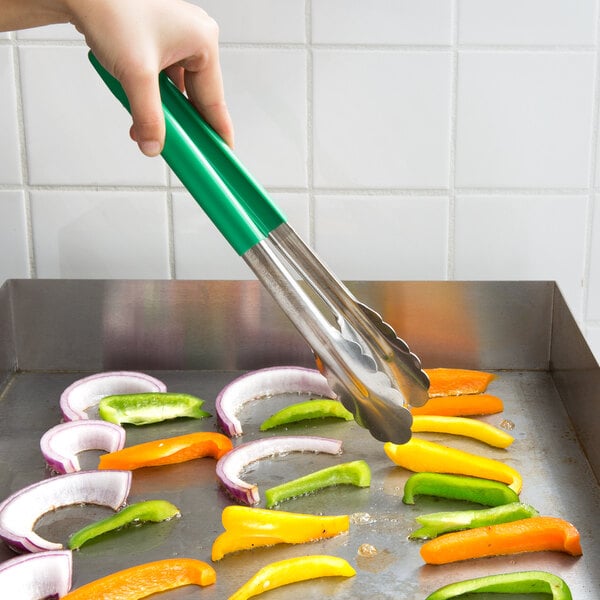
12. Coated Tongs
Color-coated tongs are cooking tongs that feature coated handles of various colors, which allows you to easily create a color-coded system in your kitchen. They are used to designate specific colored tongs to specific food groups, such as red tongs with raw meat and green tongs with produce, to prevent cross-contamination and protect customers with food allergies.
- Great for all foodservice operations
- Typically feature a one-piece construction for sanitary use
- Range in length from 6" to 22"
Tong Materials
It's important to consider the material type when choosing the right tongs for the job. If you are using tongs when cooking food, you will need some that can handle high temperatures. Furthermore, you will also need tongs that don't damage your cookware. Read on to learn more about the tong materials out there to decide which type is best for you.
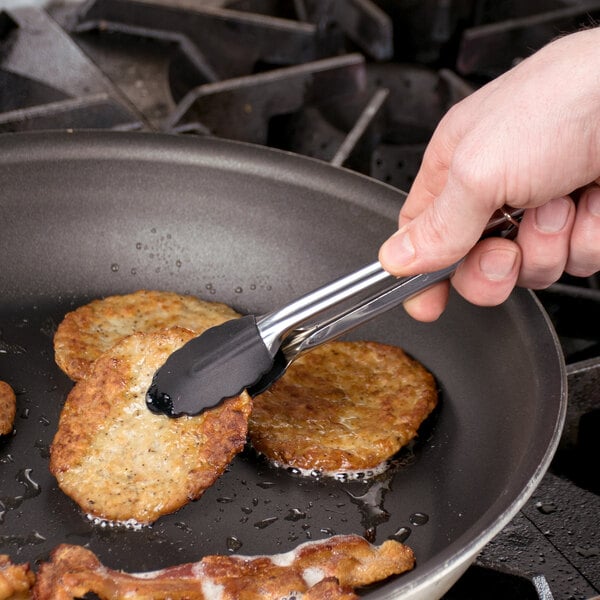

Silicone Tongs
Silicone tongs are a popular choice for many chefs and line cooks because their silicone ends are great for high-heat cooking. They won't melt or warp when subjected to high heat, making them a better, safer option for high-heat cooking than plastic and nylon tongs. They also will not damage or scratch the coating off of non-stick cookware like stainless steel tongs can.
- Can withstand high temperatures of up to 600 degrees Fahrenheit
- Ideal for use on non-stick pans
- Durable and long-lasting
- Easy to clean
- Must be verified as food-grade silicone to ensure it contains zero additives and fillers
- Potential for silicone layer over steel to wear away over time
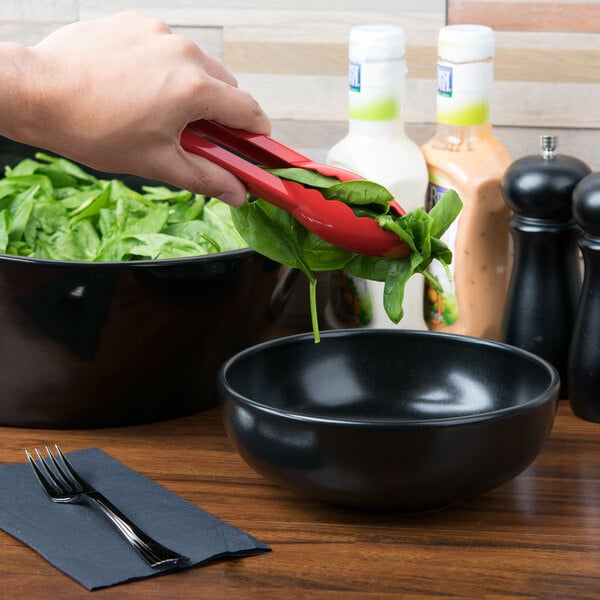

Plastic Tongs
Plastic tongs are an affordable option for front-of-house service. They can usually withstand cold temperatures as low as -40 degrees Fahrenheit and hot temperatures as high as 300 degrees Fahrenheit, making them a suitable serving option for both hot and cold foods. Plastic tongs also come in a lot of different colors to designate certain colors to certain foods in your buffet line.
- Most affordable option
- Ideal for front-of-house serving applications
- Suitable for serving both hot and cold foods
- Come in a lot of different colors
- Not ideal for high-heat cooking applications
- Not as durable as other materials
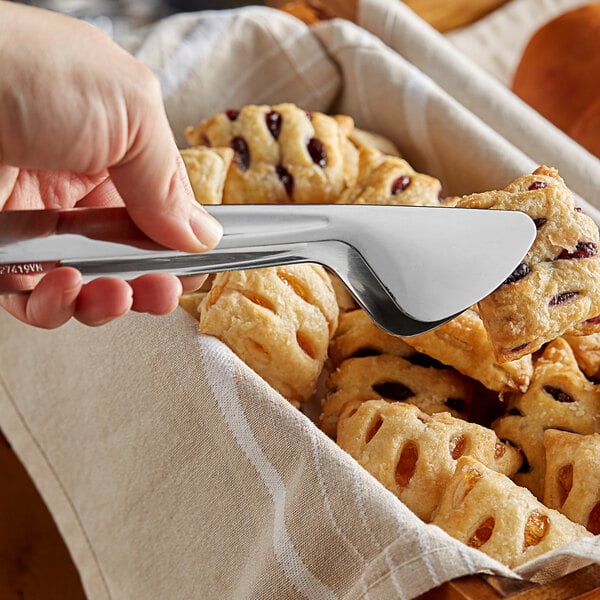

Stainless Steel Tongs
Stainless steel tongs are a tried-and-true option for chefs due to their durability and ease of cleaning. They won't melt when exposed to high-heat cooking, however, they do conduct heat so they are better for products, like meat on the grill, that the tongs will only come into contact with for a few seconds at a time. They are also commonly used as serving tongs for a clean, streamlined look.
- Won't melt when exposed to high-heat cooking
- Most durable, long-lasting material
- Easy to clean
- Can have a variety of finishes for a unique serving presentation
- Not suitable for non-stick surfaces
- Conduct heat
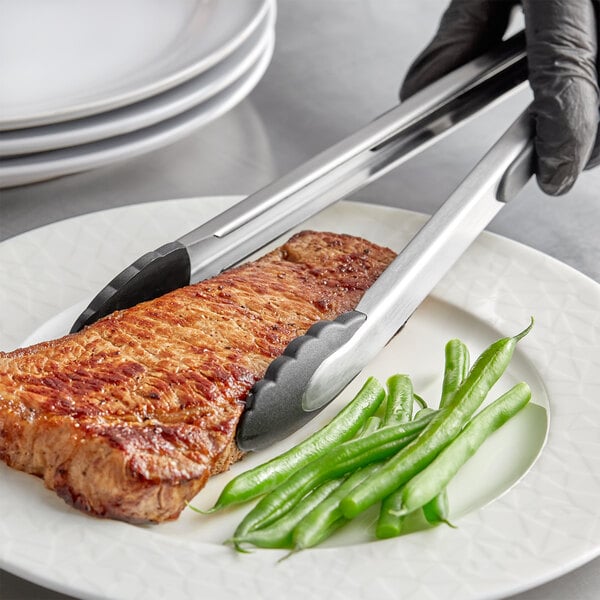

Nylon Tongs
Nylon cooking tongs are heat-resistant up to 400 degrees Fahrenheit, making them suitable for most high-heat cooking applications. Their tips will not damage or scratch the coating off of non-stick cookware and provide a firm, non-slip grip when handling foods.
- Suitable for most high-heat cooking applications
- Ideal for non-stick cooking surfaces
- Usually more affordable than silicone
- Can melt if exposed to heat higher than 400 degrees Fahrenheit
- Potential for nylon layer over steel to wear away over time
Related Resources

Types of Spatulas
Spatulas are versatile kitchen tools that are essential for any commercial kitchen. Whether you're flipping pancakes, sauteing vegetables, or icing a cake , having the right spatula for the job can make all the difference. This guide explores the different types of spatulas, including their uses and various materials available. Shop All Spatulas Use the following links to learn more about spatulas: Turner Spatula Scraper Spatula Spreading Spatula Spatula Materials How to Clean a Spatula
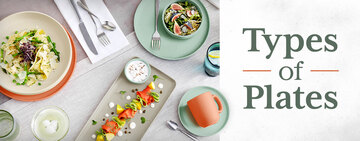
Types of Plates
When it comes to choosing plates for your commercial establishment, it's important to consider the different types available. The right type of plate can enhance the presentation of your food and contribute to a positive dining experience for your customers. Whether you're choosing plates for your restaurant or next catered event, use this guide to determine which type of plate and plate size you need based on what you're serving. Shop All China Plates Use the following links to jump to the different plates that interest you most: Dinner Plates Dessert Plates Appetizer Plates Salad Plates Charger Plates Luncheon Plates Bread and Butter Plates How to Choose the Best Plate

Types of Cookware
Choosing the best restaurant cookware for your kitchen is vital to the day-to-day operation of your foodservice business. There are many different cookware types to help you saute vegetables, create a great soup, or roast the perfect main entree. This guide will go over the different kinds of pans and pots and how to choose the best type of cookware and bakeware for your needs. Shop All Commercial Cookware Use the following links to learn about the types of cookware and bakeware out there to make more informed purchases for your kitchen! Types of Pans Types of Pots Types of Bakeware Cookware Materials Cookware Accessories Cookware Handles Cookware Forming and Thickness
- Topics 1346
- Industrial 55
- Troubleshooting Guides 21
- Restaurant Management 128
- Bar Management 55
- Catering Tips 35
- Bakery Management 42
- Food Trucks & Concessions 49
- Advertising & Marketing 37
- Eco-Friendly Tips 11
- Facility Layout & Design 41
- Coffee Shop Tips 28
- Installation & Maintenance 51
- Janitorial & Pest Control 30
- Safety & Sanitation 88
- Startup Tips 104
- Menu Design 10
- Kitchen & Cooking Tips 81
- Hospitality Management 23
- Pizza & Sandwich Shop Tips 36
- Smallwares 37
- Food Prep 88
- Tabletop Items 17
- Disposables 22
- Calculators & Tools 6
- Consumables 52
- Warewashing & Laundry 18
- Cooking Equipment 90
- Food Storage & Refrigeration 51
- Beverage Equipment 34
- Office Supplies 6
- Resource Type
- In-Depth Articles272
- Buying Guides296
- How-Tos93
- Product Reviews77


